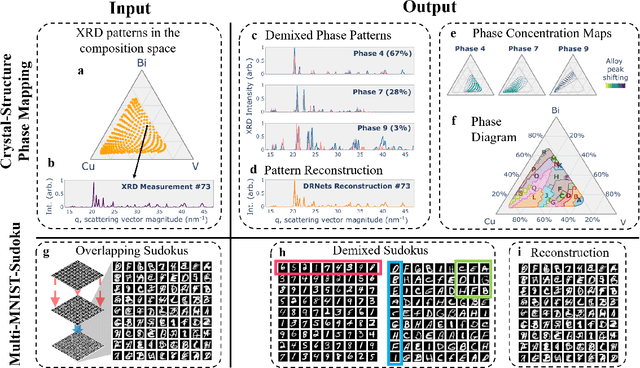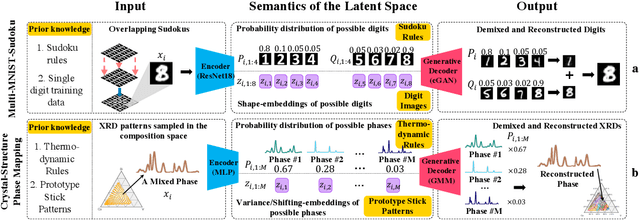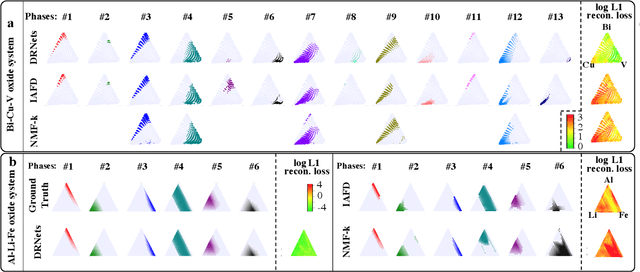Dan Guevarra
Automating Crystal-Structure Phase Mapping: Combining Deep Learning with Constraint Reasoning
Aug 21, 2021



Abstract:Crystal-structure phase mapping is a core, long-standing challenge in materials science that requires identifying crystal structures, or mixtures thereof, in synthesized materials. Materials science experts excel at solving simple systems but cannot solve complex systems, creating a major bottleneck in high-throughput materials discovery. Herein we show how to automate crystal-structure phase mapping. We formulate phase mapping as an unsupervised pattern demixing problem and describe how to solve it using Deep Reasoning Networks (DRNets). DRNets combine deep learning with constraint reasoning for incorporating scientific prior knowledge and consequently require only a modest amount of (unlabeled) data. DRNets compensate for the limited data by exploiting and magnifying the rich prior knowledge about the thermodynamic rules governing the mixtures of crystals with constraint reasoning seamlessly integrated into neural network optimization. DRNets are designed with an interpretable latent space for encoding prior-knowledge domain constraints and seamlessly integrate constraint reasoning into neural network optimization. DRNets surpass previous approaches on crystal-structure phase mapping, unraveling the Bi-Cu-V oxide phase diagram, and aiding the discovery of solar-fuels materials.
Materials Representation and Transfer Learning for Multi-Property Prediction
Jun 18, 2021



Abstract:The adoption of machine learning in materials science has rapidly transformed materials property prediction. Hurdles limiting full capitalization of recent advancements in machine learning include the limited development of methods to learn the underlying interactions of multiple elements, as well as the relationships among multiple properties, to facilitate property prediction in new composition spaces. To address these issues, we introduce the Hierarchical Correlation Learning for Multi-property Prediction (H-CLMP) framework that seamlessly integrates (i) prediction using only a material's composition, (ii) learning and exploitation of correlations among target properties in multi-target regression, and (iii) leveraging training data from tangential domains via generative transfer learning. The model is demonstrated for prediction of spectral optical absorption of complex metal oxides spanning 69 3-cation metal oxide composition spaces. H-CLMP accurately predicts non-linear composition-property relationships in composition spaces for which no training data is available, which broadens the purview of machine learning to the discovery of materials with exceptional properties. This achievement results from the principled integration of latent embedding learning, property correlation learning, generative transfer learning, and attention models. The best performance is obtained using H-CLMP with Transfer learning (H-CLMP(T)) wherein a generative adversarial network is trained on computational density of states data and deployed in the target domain to augment prediction of optical absorption from composition. H-CLMP(T) aggregates multiple knowledge sources with a framework that is well-suited for multi-target regression across the physical sciences.
Autonomous synthesis of metastable materials
Jan 19, 2021



Abstract:Autonomous experimentation enabled by artificial intelligence (AI) offers a new paradigm for accelerating scientific discovery. Non-equilibrium materials synthesis is emblematic of complex, resource-intensive experimentation whose acceleration would be a watershed for materials discovery and development. The mapping of non-equilibrium synthesis phase diagrams has recently been accelerated via high throughput experimentation but still limits materials research because the parameter space is too vast to be exhaustively explored. We demonstrate accelerated synthesis and exploration of metastable materials through hierarchical autonomous experimentation governed by the Scientific Autonomous Reasoning Agent (SARA). SARA integrates robotic materials synthesis and characterization along with a hierarchy of AI methods that efficiently reveal the structure of processing phase diagrams. SARA designs lateral gradient laser spike annealing (lg-LSA) experiments for parallel materials synthesis and employs optical spectroscopy to rapidly identify phase transitions. Efficient exploration of the multi-dimensional parameter space is achieved with nested active learning (AL) cycles built upon advanced machine learning models that incorporate the underlying physics of the experiments as well as end-to-end uncertainty quantification. With this, and the coordination of AL at multiple scales, SARA embodies AI harnessing of complex scientific tasks. We demonstrate its performance by autonomously mapping synthesis phase boundaries for the Bi$_2$O$_3$ system, leading to orders-of-magnitude acceleration in establishment of a synthesis phase diagram that includes conditions for kinetically stabilizing $\delta$-Bi$_2$O$_3$ at room temperature, a critical development for electrochemical technologies such as solid oxide fuel cells.
 Add to Chrome
Add to Chrome Add to Firefox
Add to Firefox Add to Edge
Add to Edge